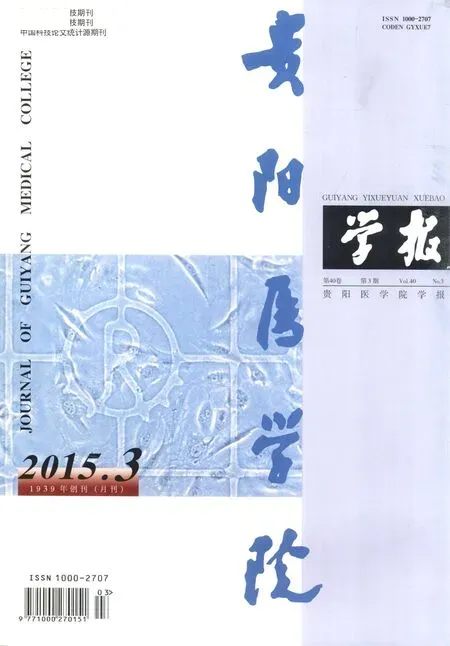右美托咪定用于七氟醚誘導氣管插管時血流動力學及BIS的變化*
?
右美托咪定用于七氟醚誘導氣管插管時血流動力學及BIS的變化*
網絡出版時間:2015-03-19網絡出版地址:http://www.cnki.net/kcms/detail/52.5012.R.20150319.1014.024.html
咸淑悅, 周妙苗, 馬敏, 王成夭**
(武漢大學中南醫院 麻醉科, 湖北 武漢430071)
[摘要]目的: 觀察右美托咪定對七氟醚誘導氣管插管時血流動力學及鎮靜深度的影響。方法: 擇期全麻下行耳鼻喉手術患者36例,ASA分級Ⅰ~Ⅱ級,隨機均分為對照組(A組)、高劑量芬太尼組(B組)、右美托咪定組(C組),A、B組誘導時分別給予芬太尼2 μg/kg和4 μg/kg,C組麻醉誘導前15 min內靜脈泵注右美托咪定1.0 μg/kg,誘導時給予芬太尼2 μg/kg;3組均給予七氟醚“潮氣量法”誘導,記錄3組患者給藥前(T0)、開始吸入七氟醚即刻 (T1)、氣管插管前即刻 (T2)、氣管插管后即刻 (T3)的收縮壓(SBP)、舒張壓(DBP)、心率(HR)、腦電雙頻指數(BIS)并分析。結果: 3組患者T0時點基礎BIS、SBP、DBP及HR比較;差異無統計學意義(P>0.05);T1與T0時點比較,C組SBP、HR及BIS值顯著低于A、B兩組,T2時點C組患者的SBP 顯著高于A、B兩組,差異有統計學意義(P<0.05);T3時點C組患者的SBP、DBP及HR顯著低于A組,BIS低于A、B兩組,差異有統計學意義(P<0.05)。結論: 七氟醚誘導插管時右美托咪定在降低BIS的同時可維持穩定的血流動力學。
[關鍵詞]右美托咪定; 七氟醚; 腦電雙頻指數; 血流動力學; 插管法,氣管內
七氟醚用于麻醉誘導有較好的有效性和安全性。較低濃度的七氟醚對循環系統的抑制作用小于其它靜脈麻醉藥物,但不能有效的抑制氣管插管對血流動力學產生的應激反應;高濃度的七氟醚對循環系統的抑制增加,易造成血流動力學紊亂,因此常需聯合使用其它藥物使麻醉誘導插管過程更加平穩。有研究報道麻醉前使用右美托咪定可維持麻醉誘導時血流動力學平穩,并可減少麻醉藥物用量。本文用1.0 μg/kg負荷劑量右美托咪定聯合七氟醚進行麻醉誘導,探討美托咪定用于七氟醚誘導氣管插管時血流動力學及雙頻指數(BIS)的變化,報道如下。
1資料與方法
1.1 對象及分組
擇期全麻下行耳鼻喉手術治療的患者36例,ASA評分Ⅰ~Ⅱ級,年齡20~55歲,體重指數<28 kg/m2,所有患者術前無心血管、呼吸及內分泌系統疾病史,未使用心血管活性藥物,無精神病史及藥物過敏史,無電解質紊亂、肝腎功能異常。在獲醫院倫理委員會批準,病人知情同意情況下,隨機將手術患者均分為對照組(A組),高劑量芬太尼組(B組),右美托咪定組(C組)。3組患者性別比、年齡、體重、體重指數比較差異無統計學意義(P>0.05)。
1.2 方法
所有受試者術前45 min給予阿托品0.5 mg靜脈注射,入室連續監測患者BIS、收縮壓(SBP)、舒張壓(DBP)、心率(HR)及脈搏氧飽和度(SpO2),監測呼氣末二氧化碳濃度(PETCO2)及呼氣末七氟醚濃度(CETSev)。A、B兩組誘導時分別給予芬太尼2 μg/kg和4 μg/kg;C組患者于麻醉誘導前15 min內靜脈泵注濃度4 μg/mL的右美托咪定1.0 μg/kg,誘導時給予芬太尼2 μg/kg。3組患者均給予七氟醚“潮氣量法”誘導,吸入七氟醚濃度為8%,新鮮氧流量為6 L/min,半緊閉回路,緊閉面罩囑患者平靜呼吸,開始吸入七氟醚時立即給予芬太尼,30 s內推注,待患者睫毛反射消失后將七氟醚濃度調至5%,同時給予羅庫溴銨0.6 mg/kg,行輔助控制通氣。吸入誘導3 min后行氣管插管(男性7.5號彈簧管,女性7.0號彈簧管)。1 min內完成插管,之后行機械通氣IPPV模式,潮氣量8~10 mL/kg,呼吸頻率12次/min,吸呼比1∶2。
1.3 觀察指標
記錄給予右美托咪定前(T0)、開始吸入七氟醚即刻(T1)、氣管插管前即刻(T2)及氣管插管后即刻(T3)4個時點的BIS、SBP、DBP及HR。
1.4 統計學處理

2結果
三組患者T0時點基礎BIS、SBP、DBP及HR比較,差異無統計學意義(P>0.05)。T1與T0時點比較,C組患者SBP、HR及BIS均低于A、B兩組,差異有統計學意義(P<0.05)。T2時點與T1時點比較,A組與B組患者的SBP、DBP、HR、BIS均顯著降低,C組患者僅SBP與BIS顯著降低,差異有統計學意義(P<0.05)。T3時點與T2時點比較A、B組患者SBP、DBP、HR、BIS均顯著升高(P<0.05),而C組患者則無顯著變化(P>0.05)。T1時點C組患者的HR、BIS顯著低于A、B兩組,T2時點C組患者的SBP顯著高于A、B兩組,T3時點C組患者的SBP、DBP、HR顯著低于A組, BIS值顯著低于A、B兩組,差異有統計學意義(P<0.05)。見表1。
3討論
全身麻醉誘導后行氣管插管可引起強烈的心血管反應,主要由于刺激了位于咽喉部和氣管內的感受器,導致交感-腎上腺髓質系統興奮性增強。研究顯示,喉鏡置入之后30~45 s時的心血管反應最為強烈,大約持續3~5 min。而機

表1 三組手術患者各時點BIS、SBP、DBP及
(1)與組內T1時點比較,P<0.05;(2)與組內T2時點比較,P<0.05;與C組同一時點比較,(3)P<0.05
體血壓與心率的變化同血漿兒茶酚胺的水平是相一致的。右美托咪定是一種強效的、高選擇性的α2腎上腺素受體激動劑,通過減少去甲腎上腺素在神經效應接頭的釋放,產生降低交感神經張力的作用,使血壓輕度下降和心率中度下降。當持續輸注右美托咪定時,能達到期望的穩定的血流動力學反應。本研究結果顯示給予負荷量右美托咪定后,患者血壓、心率顯著降低,與Kunisawa等的研究結果一致。C組患者麻醉誘導插管過程中血壓與心率波動較小,表明麻醉誘導前給予1 μg/kg負荷劑量右美托咪定能夠使七氟醚吸入麻醉誘導插管過程血流動力學更加平穩。
BIS可用于定量監測大腦的鎮靜深度,BIS值與患者的鎮靜深度具有良好的一致性[10]。在七氟醚麻醉中BIS也可作為可靠的監測鎮靜水平和麻醉深度的指標[11]。本試驗輸注右美托咪定后C組BIS值顯著降低(P<0.05)。而氣管插管后C組BIS值無明顯變化,A組和B組BIS值較插管前升高(P<0.05),且高于C組(P<0.05),表明右美托咪定可加強七氟醚麻醉的鎮靜效應。
綜上所述,麻醉前給予1 μg/kg負荷劑量右美托咪定可降低BIS值同時可維持七氟醚誘導插管過程中穩定的血流動力學。
參考文獻4
[1]Liu SJ, Li Y, Sun B, et al. A comparison between vital capacity induction and tital breathing induction techniques for the induction of anesthesia and compound A production. Chin Med J (Engl), 2010(17):2336-2340.
[2]顏學滔,程曉莉,高濤,等.右美托咪定對七氟烷吸入麻醉誘導氣管插管應激反應的影響.湖北民族學院學報:醫學版, 2012(1):1-3.
[3]Hye WS, Hye NY, Dong HK,et al. Preanestheticdexmedetomidine 1 μg/kg single infusion is a simple,easy,and economic adjuvant for general anesthesia.Korean J Anesthesiol, 2013(2):114-120.
[4]Heeseung Lee. The Pentax airway scope versus the Macintosh laryngoscope: Comparison of hemodynamic responses and concentrations of plasma norepinephrine to tracheal intubation . Korean J Anesthesiol, 2013(4):315-320.
[5]李民,蔡宏偉,陳雪華. 舒芬太尼誘導對氣管插管條件和血流動力學的影響 . 貴陽醫學院學報, 2010(3):268-271.
[6]吳偉強. 鹽酸右美托咪啶在全身麻醉腹部手術拔管期的應用. 貴陽醫學院學報, 2013(4):404-405.
[7]Yu J, Lu Y, Dong C, et al. Premedication with intravenous dexmedetomidine-midazolam suppresses fentanyl-induced cough.Ir J Med Sci, 2012(4):517-520.
[8]Pyry AV, Tuula AS, Andrew W, et al. Population Pharmacokinetics of Dexmedetomidine in Critically ш Patients . Clin Drug Investig, 2013(8):579-587.
[9]Kunisawa T, Nagata O, Nagashima M, et al. Dexmedetomidine suppresses the decrease in blood pressure during anestheticinduction and blunts the cardiovascular response to tracheal intubation. J ClinAnesh, 2009(3):194-199.
[10]Saeed A, Reihanak T, Babak J, et al. Bispectral index response to cricoid pressure during induction of general anesthesia . J Res Med Sci, 2011(1):63-67.
[11]Tae KS, Min KH, Hee JL, et al.Bispectral index and their relation with consciousness of the patients who receive desflurane or sevoflurane anesthesia during wake-up test for spinal surgery for correction. Korean J Anesthesial, 2012(1):13-18.
(2015-01-05收稿,2015-02-21修回)
中文編輯: 吳昌學; 英文編輯: 劉華
Effect of Dexmedetomidine on the Hemodynamic and BIS during
Anesthetic Induction with Sevoflurane and Tracheal Intubation
XIAN Shuyue, ZHOU Miaomiao, MA Min, WANG Chengyao
(DepartmentofAnesthesiology,ZhongnanHospitalofWuhanUniversity,Wuhan430071,Hubei,China)
[Abstract]Objective: To observe the effect of dexmedetomidine on the hemodynamic and BIS during anesthetic induction with sevoflurane and tracheal intubation. Methods: Thirty-six American Society of Anesthesiology (ASA) physical status I and II patients, undergoing selective otorhinolaryngologic operation under general anesthesia were randomly divided into three groups. Group A received saline solution 15 minutes before anesthetic induction and fentanyl 2 μg/kg during induction; Group B received saline solution 15 minutes before anesthetic induction and fentanyl 4 μg/kg during induction; Group C received dexmedetomidine at an initial dose of 1.0 μg/kg 15 minutes before anesthetic induction and fentanyl 2 μg/kg during induction. Patients of the three groups all received tidal breathing induction with sevoflurane. The hemodynamic parameters: systolic blood pressure(SBP), diastolic blood pressure(DBP), heart rate(HR) and BIS were recorded at four time points: the moment before the use of saline solution or dexmedetomidine (T0), the moment before sevoflurane induction(T1), the moment before intubation(T2) and the moment after intubation(T3).Results: Compared with T0, SBP and HR of Group C at T1were significantly lower than those of Group A and Group B (P<0.05); SBP of Group C was siginificantly higher than that of Group A and Group B at T2(P<0.05); At T3, SBP, DBP and HR of Group C were significantly lower than those of Group A (P<0.05) while BIS of Group C was lower than that of Group A and Group B (P<0.05). Conclusion: Dexmedetomidine can reduce BIS value and make the hemodynamic stable during the induction with sevoflurane and tracheal intubation.
[Key words]dexmedetomidine; sevoflurane; bispectral index; hemodynamic; intubation,intra tracheal
[中圖分類號]R614.24
[文獻標識碼]A
[文章編號]1000-2707(2015)03-0294-03
通信作者**E-mail:my-307@163.com
[基金項目]*武漢大學自主科研青年教師項目(No:2042014kf0188)

